140 Years Of A German Family Of Shipowners
![]()
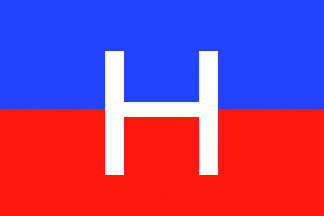 Heinrich Christian Horn (1837-1899) was born in Kiel and moved to Schleswig, a town that was then part of Denmark, some fifteen miles south of Flensburg, in 1860. He settled into a house with a nearby factory building for the production of matches four years later, in the same year that Schleswig became part of Prussia instead of Denmark. He also began to trade in commercial goods such as fish from Scotland, and from coal from England from 1869. This led to a move into shipping in 1879, when he took over three small craft carrying goods and passengers on the river Schlei, which stretches for twenty miles from the Baltic near Kappeln and Arnis to the town of Schleswig. The summer passenger trade on the Schlei was complemented by the winter trades in coal.
Heinrich Christian Horn (1837-1899) was born in Kiel and moved to Schleswig, a town that was then part of Denmark, some fifteen miles south of Flensburg, in 1860. He settled into a house with a nearby factory building for the production of matches four years later, in the same year that Schleswig became part of Prussia instead of Denmark. He also began to trade in commercial goods such as fish from Scotland, and from coal from England from 1869. This led to a move into shipping in 1879, when he took over three small craft carrying goods and passengers on the river Schlei, which stretches for twenty miles from the Baltic near Kappeln and Arnis to the town of Schleswig. The summer passenger trade on the Schlei was complemented by the winter trades in coal.
In 1881, H. C. Horn sought partners interested in forming a larger shipping partnership, a Partenreederei, for the trades in fish and coal across the North Sea. He had been made the Swedish-Norwegian consul in 1871, and was thus well known in the town with people keen to buy shares in the new partnership. A small cargo ship of 563 grt and able to carry six hundred tonnes of cargo was ordered from the H. F. Ulrichs yard in Vegesack, with a steam engine of 240 horse power for the construction cost of 185,000 Deutsche marks. Stadt Schleswig was launched on 21st August 1883 at Vegesack, and made her maiden voyage across the North Sea to Scotland to load salted fish and coal. She arrived back in her home town and was greeted by the partners and citizens of Schleswig.
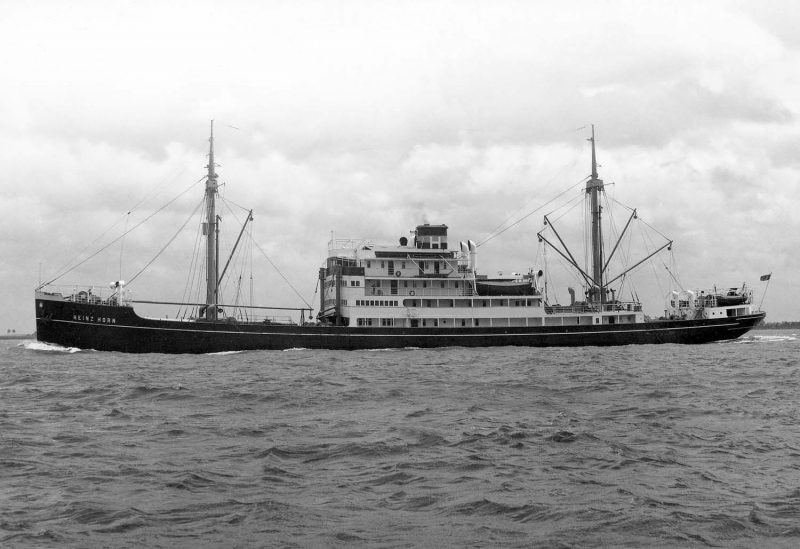
The second cargo ship was named Therese Horn of 603 grt when delivered in 1888 at a construction cost of 183,000 Deutsche marks from the Rostock Shipbuilding and Engineering yard. The return on the investment by the partners in the first two years gave a useful yield of between 14% and 20% during this period of trading. The third vessel was Minna Horn of 699 grt, also from the Rostock Shipbuilding and Repairing yard, and the fourth and fifth vessels were Marie Horn of 1,217 grt and Franz Horn of 1,509 grt and 2,300 dwt from the Neptun A. G. yard during 1896/98. The founder, Heinrich Christian Horn, died in 1899 aged 62 years, and his widow Therese Horn took over the shipping company during the years from 1899 to 1903, which was then passed to the elder son, Henry Horn.
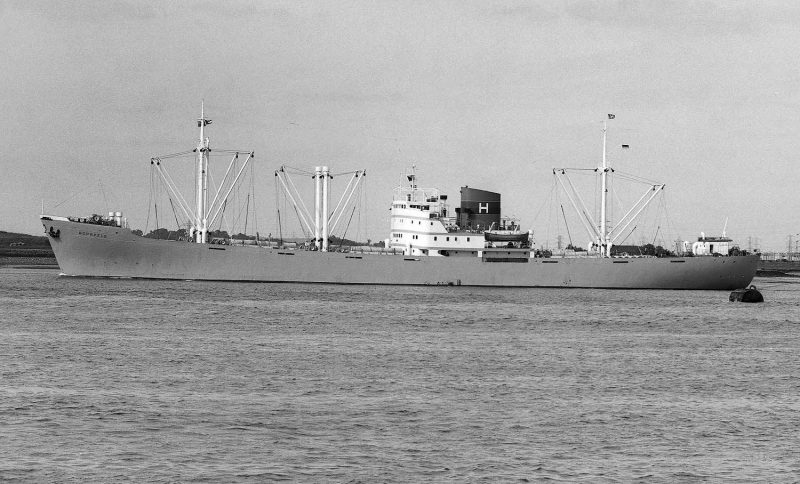
Two Horn Brothers And Two Horn Fleets
The younger brother Franz Horn remained a shareholder in the ‘Flensburger Horn’ shipping company of his brother, but founded his own shipping company in Lubeck in 1901 as Dampschiffs Rhederei Horn A.G., and known as the ‘Lubecker Horn’ family shipping company. The ships were indistinguishable from the ships of his elder brother with the same houseflag, hull and funnel colours. Seven fruit ships of the Fruchdampfer A.G., formed in 1904, voyaged as far as the Mediterranean and the Canary Islands to load fruit in cooled holds for transport to Germany and the U.K. ports. Vessels of the ‘Flensburger Horn’ had the suffix ‘Horn’ to their names e.g. Hilda Horn of 1900, whereas vessels of the ‘Lubecker Horn’ had the prefix ‘Horn’ e.g. Horncap of 1906.
Marine casualties reduced the size of the fleet all of the time, with the first ship, Stadt Schleswig, lost in 1910 at sea, while Frida Horn built in 1900 stranded on Lille Sommaro island in the Baltic three years after completion and was lost. Luise Horn dating from 1899 disappeared in the North Sea eight years later, while Hersilia of 1901 stranded near Oporto on 15th November 1912 and was lost. Riddha was completed by the Tonning yard of Schomer and Jensen in 1902 but stranded after only a couple of voyages on Tiree in West Scotland on 10th June of that year and was lost. Two ships built in 1904 soon came to grief, with Hornstein from the Neptun A.G. yard in Rostock striking a rock on the Savo Reef near Faro on 16th November 1905 and was lost, while Therese Horn completed at Flensburg disappeared at sea eight years later.
The size of the ‘Flensburger Horn’ fleet had reached seventeen vessels by 1903, operating in the worldwide tramp trades and the North Sea and Baltic Sea trades of coal and timber. This fleet increased in size to 21 steamers of 33,000 grt in 1905, and the combined fleet of the two brothers, Henry Horn and Franz Horn, was 38 steamers of 77,500 grt in 1906. The average age of the fleet was low at only three years, and by the outbreak of war in August 1914, the combined Horn fleets were the largest tramp fleet in Germany with a carrying capacity of 125,000 dwt. Three large tramps of 6,150 dwt were built by the Stockton yard of Craig, Taylor & Co. Ltd. for the combined fleet in Hornfels (2), Luise Horn and Hornfels (3), with Hornfels (2) sold shortly after completion to the Atlas Bremer Steamship Company managed by Deutsche Levant Line and renamed Haidar Pascha.

World War I
Some of the ships of the big combined Horn fleets were immediately interned on the outbreak of war at ports all over the world, including Manchester, Bordeaux, Sao Nicolao in Portugal, Bilbao, Vigo, Havana, New York, San Luis de Maranhao in Brazil, and in other ports, and were then seized by the Governments of the countries where they had been interned after being laid up for a period of two or three years. These ships did not return to German ports at the end of the war, neither did Franz Horn and Marie Horn, which were captured by British warships on 5th August 1914 and 16th July 1917 respectively and became part of the British wartime fleet. Hornfels (2) was seized at Alexandria by British forces as Haidar Pascha and renamed Hunsbridge, only to be torpedoed and sunk by UB49 on 7th September 1917 sixty miles from Cape Spartel while on a voyage from Swansea to Gibraltar with coal and stores, two crew members being lost.
Four of the Rickmers tramp fleet that had been bottled up in the Port of Hamburg since the start of the war, were purchased by the Horn brothers in 1917 as Andre Rickmers, Elisabeth Rickmers, Mai Rickmers, and Madeleine Rickmers and were renamed Hilda Horn, Hornhoh, Hornstein and Minna Horn respectively. They were taken over by the Allies in 1919 and given as war compensation to the British and Italian Governments. Some Horn vessels became marine casualties during the war, with Heinrich Horn stranded at Langeoog on 2nd December 1917, and becoming a constructive total loss to be broken up. Claus Horn stranded in the Baltic on 30th October 1915 and was lost after only eight years of service. Ingrid Horn was sunk in a collision off Dalaro near Stockholm with the Swedish steamer Bergevik during 1917. Three of the Horn fleet given to the U.K. in 1919 as war compensation were sold off to the Byron Steamship Co. Ltd. and renamed Maid of Crete (ex Mimi Horn), Maid of Syria (ex Horncap), and Maid of Andros (ex Luise Horn). The other prize vessels seized in 1919 were given as war compensation to the French, Italian and Spanish Governments.
Inter-War Years
The old steamer Irmgard Horn of 1,484 grt built back in 1902 by the Neptun A.G. yard at Rostock, was the only vessel left in the combined Horn fleets at the end of the war. She was despatched to the Caribbean in 1920 to explore whether a liner service to the West Indies was feasible. This proved successful with a dozen motor vessels then constructed in German yards for the Caribbean liner service, with a subsidiary set up as the West Indies Shipping Company Gmbh in 1934. The ‘Lubecker Horn’ shipping company was much reduced from 1917, as the son of Franz Horn, who had been appointed as his successor after his death, had been killed in action in Flanders. The last ten ships of the ‘Lubecker Horn’ were sold in 1926 to Norddeutscher Lloyd (NDL) of Bremen. Hornfels of 7,400 dwt, built in 1921 at the Henry Koch yard in Lubeck, of this group of ten ships gave another eleven years of service before a stranding in 1937 ended her career. Heinz Horn was the only son of Henry Horn of the ‘Flensburger Horn’ shipping company, and he travelled extensively in the Caribbean and Central America in 1923 to establish an agency network for the new liner company.
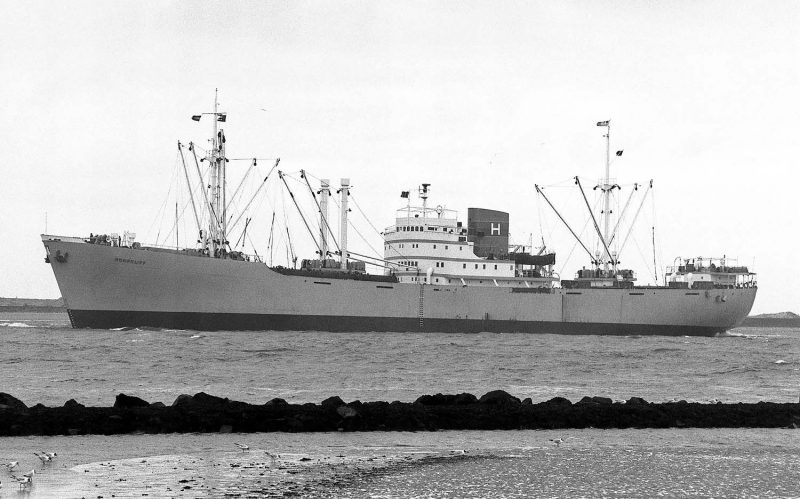
The steamer Hilda Horn of 1,412 grt built back in 1900 by the Neptun A.G. yard at Rostock, was repurchased in May 1920 and renamed Marie Horn and served as a North Sea collier until sold in 1923 to the Kohlen Import A.G. and renamed Koholyt to continue in the coal trade. A large steamer of 8,500 dwt was completed by the Schichau yard at Danzig in 1922 as Therese Horn, but she could not offer the same economy of operation of the motorships and was sold two years later to Essex Line of London (Meldrum and Swinson, managers) and renamed Essex Envoy. The steamer Nord Friesland was completed in 1922 at the Krupp yard at Kiel and purchased two years later and renamed Claus Horn, but was soon sold on to the Booth Steamship Co. Ltd. of Liverpool and renamed Dominic for Brazilian trading with passengers and cargo.
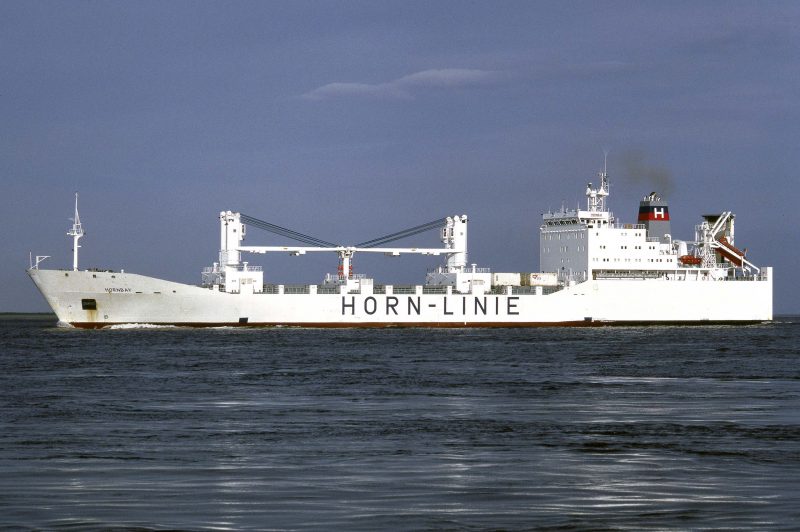
The fleet of new motorships with a labour saving small engine room staff always refuelled with cheap oil at the port of Willemstad in Curacao. These ships were Consul Horn of 1924, Henry Horn of 1924, Therese Horn of 1924, Claus Horn of 1925, Frida Horn of 1925, Marie Horn of 1925, Waldtraut Horn of 1926, Mimi Horn of 1928, Heinz Horn of 1928, Ingrid Horn of 1928, Presidente Gomez of 1928, and H. C. Horn of 1932, as well as the smaller twin screw motor vessel Karibia built at Rotterdam in 1922 purchased in 1928 and renamed as Zulia a year later.
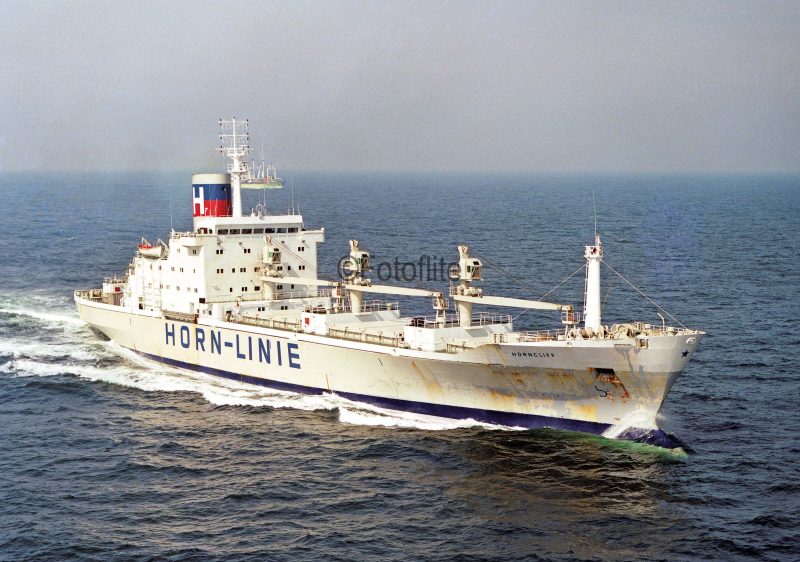
The dozen larger motorships were of 5,200 dwt with accommodation for between 32 and forty First Class passengers on their voyages to the warm Caribbean. They had been constructed by the Flensburger Schiffs yard at Flensburg, Reihersteig yard in Hamburg, Krupp yard in Kiel and Schichau yard in Danzig, and were powered by four or six cylinder Sulzer Krupp diesel engines to give a service speed of thirteen knots. They had black hulls with a white line and red boot topping, and four decks high of ‘midships accommodation, which gave the impression when fully loaded that they were ‘sagging’ midships. A heavy lift derrick was fitted on the foremast and mainmast for lifts into number two hold and the aft holds, and there were ten more derricks on the foremast and mainmast and a set of posts in front of the navigating bridge. A large number of white ventilation cowls with red insides were clustered around the black funnel, which had a white ‘H’ superimposed on blue over red bands.
The Horn fleet of motorships became a member in 1927 of the West Indies Conference to give the company the higher freight rates that the Conference could charge, and further competition with Hapag was reduced in 1931 when a pool was set up by Horn and Hapag, the biggest German shipping company. In the depths of the Depression, the Horn Head Office was moved from Flensburg to Hamburg in 1933 at the request of the banks, again to reduce costs accrued from a more central German location.
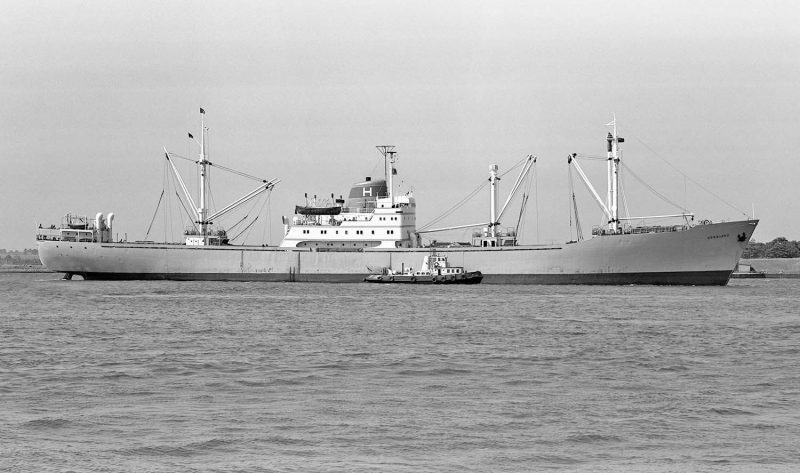
Erich Muller-Stinnes purchased a considerable block of shares in Horn Line in 1933 and became a partner, as the company was having financial difficulties, and he helped it out of a crisis. Henry Horn remained in the company for only a short while after the move to Hamburg, entrusting his son Heinz with the management of the company after his death in 1937 on his large estate. The first of the new motorships were also sold to provide funds for the recovery, as freight rates were improving by 1934. Erich Muller-Stinnes and Heinz Horn each had 50% of the shares of the West Indies Shipping Company Gmbh founded in 1934.
Heinz Horn took over two old larger cargo-liners of 7,800 grt in 1939, built back in 1904 by the Belfast yard of Harland & Wolff Ltd. with accommodation for 190 passengers in Tourist Class. They had been built as Mamari and Matatua for Shaw, Savill and Albion Co. Ltd., and one was renamed Consul Horn after purchase from Arnold Bernstein as Gerolstein, and the other as Ilsenstein was sold for scrapping at Blyth, but after her arrival there she was towed to Scapa Flow and sunk as a blockship. Consul Horn was registered under the West Indies Shipping Company Gmbh before being sold to the Kriegsmarine for the German war effort and sank after she hit a mine off Borkum in June 1942.
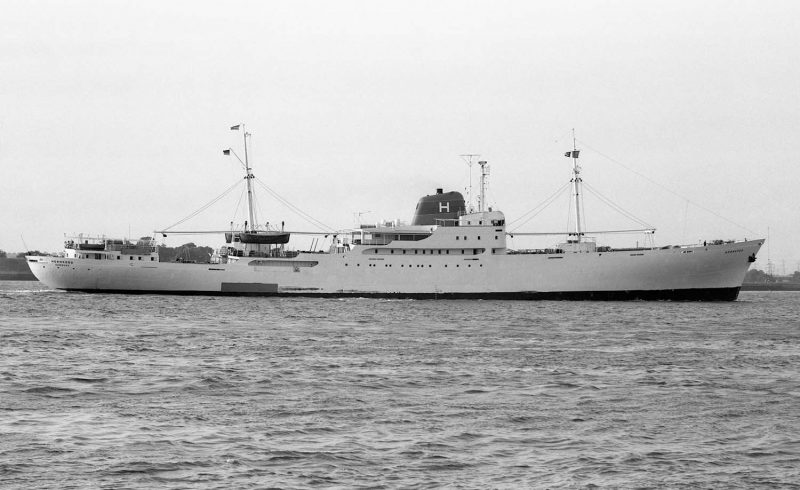
World War II
The fleet of ten ships on the outbreak of war in September 1939 were requisitioned for duty with the Kriegsmarine, the German Navy, as U boat tenders or ‘Sperrbrechers’ i.e. auxiliary minesweepers that sailed ahead of other vessels through minefields, intending to detonate any mines in their path. H. C. Horn became Sperrbrecher 27, Ingrid Horn became Sperrbrecher 25, and Waldtraut Horn became Sperrbrecher 24, and with only Waldtrout Horn surviving the war of this trio. Claus Horn (ex Minna Horn) became the U boat tender Neisse, and after the war served as an accommodation ship for Kiel University and was then sold to Yugoslavia in 1947 and renamed Topusko. The full list of wartime careers and losses was:-

- Frida Horn was ceded to the U.K. in May 1945 and allocated to Russia on 25th February 1946 and renamed Bogdan Khmelnitzki.
- Ravenstein (ex Hansa) was scuttled at Gotenhafen as a blockship on 27th March 1945.
- H.C. Horn served as Sperrbrecker 27, but was bombed and badly damaged at Travemunde on 2nd May 1945, and was scuttled in the Skagerrak with poison gas shells in July 1946.
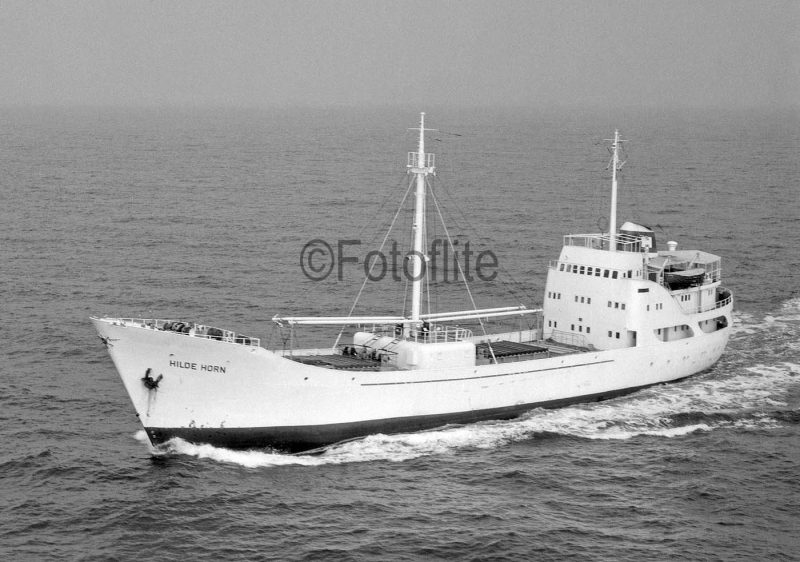
- Heinz Horn was renamed Heinz and survived the war to be allocated to Holland as Betuwe, and was broken up in 1961 after a 33 year career in 1961 under the name of Alderney.
- Henry Horn (ex Waldtraut Horn) was captured off Curacao on 10th May 1940 and sailed as Bonaire under the Dutch flag.
- Ingrid Horn served as Sperrbrecher 25 but was bombed and sunk at Kiel by R.A.F. bombers, and was raised and broken up after the war.
- Mimi Horn (6) was scuttled on 28th March 1940 in the Denmark Strait to avoid capture after interception by the Armed Merchant Cruiser (AMC) Transylvania.
- Waldtraut Horn (ex Presidente Gomez) served as Sperrbrecher 24 and was allocated to Russia on 17th January 1946 and renamed Kushka.
- Mimi Horn (7) was a war built vessel from the Nakskov yard in Denmark but was sunk by Russian aerial torpedo in the Baltic on 14th January 1945.
The Hamburg Kontorhaus Head offices of the Horn shipping company were completely destroyed by air raids, and with the loss of its fleet it was several years and many problems later before a new fleet could be ordered.
Post-War Years
Heinz Horn as a partner in the company was personally liable for the mortgages on the ships lost in the war, and it was left to Ernst Muller-Stinnes to start the Horn Line fleet alone in 1949, as Heinz Horn transferred his shares in the West Indies Shipping Company Gmbh to him. A fleet of good sized reefer fruit ships was then built in the 1950s by the Deutsche Werft yard in Hamburg, starting with Hornfels in 1951, Hornbay and Horncap in 1955, Hornkoog in 1959, Horndeich in 1960, and other reefers of usually 7,500 dwt with accommodation for ten First Class passengers. These included Hornbaltic (1954), Hornbelt (1959), Hornberg (1953), Horngolf (1970), Hornkliff (1954), Hornkoog (1959), Hornland (1957), Hornmeer (1969), Hornsee (1959), Hornstern (1957), Hornsund (1951) and Hornwind (1969).
Most of this big fleet built in the 1950s had five holds served by at least fourteen derricks on two masts and a set of posts for unloading pallets of fruit, including a heavy lift derrick on the foremast.
Hornberg was given masthouses that most of her near sisters lacked, but all of these reefer ships built in the 1950s had lengths of around 432.0 feet and a moulded beam of 21.6 feet. They carried a dozen passengers in some style to the Caribbean and Central America, and Hornbelt and her sister Hornsee of 1959 had a larger carrying capacity of nine thousand tonnes. Horndeich and her sister Hornkoog of 1960 were given a much more streamlined appearance with four holds and two raked masts and a ‘cutaway’ stern and dimensions of length 442.0 feet and a moulded beam of 20.1 feet.
Hornland, built by the Deutsche Werft yard in 1957, was sunk by collision on 27th October 1967 in the Nieuw Waterway with the motor vessel Presidente Pierre Angot in the main channel, but the wreck was raised and towed to Rotterdam for repairs, and she was back in service a year later. She also had a severe engine room fire, as if her sinking was not enough, in 1973 and was declared a total loss but was later repaired and she was back in service a year later. She was finally broken up in 1983 after 27 years of accidents and trading. Three Baltic feeder reefers of 999 grt or less operated between 1963 and 1997 in Hornbaltic (1) purchased in 1963 and sold in 1972, Hornbaltic (2) completed in 1979 and beached after a collision on 29th October 1985, and then salved and sold, and Hornbelt built in 1980 which moved to the Liberian subsidiary of Horn Line in 1995 and was sold two years later.
Heinz Horn was able to sort out his financial affairs and begin again as a shipowner in 1956 under the title of H. C. Horn. A series of grey hulled twin hold smaller reefers of up to 1,500 dwt was built during the next five years in the Hamburg yard of J. J. Sietas as Consul Horn, Therese Horn, Ingrid Horn, Hilde Horn, Dora Horn, Stadt Schleswig, Heinz Horn, Marie Horn, Irmgard Horn, Ursula Horn, Harald Horn, Caroline Horn and Luise Horn. They traded in the small fish and fruit niche markets until this company was bankrupted in 1969, and then taken over by Hamburg Sud.
Ernst Muller-Stinnes became the general representative for French Line, but died in 1963 without any descendants, and 50% of Horn Line with its big fleet of reefers was sold to Hapag and 50% to French Line (CGT) in 1963. The French Line was to play a big part in the operation of the Horn Line during the 1960s and 1970s, and obtained the shares in the company held by Hapag in 1978, by which time French Line had merged with Messageries Maritimes of Marseille to form Compagnie General Maritime (CGM). Horn Line had only four reefers in its fleet in 1974 in Hornbelt of 1959, Horngolf of 1970, Hornmeer of 1969 and Hornwind of 1969.
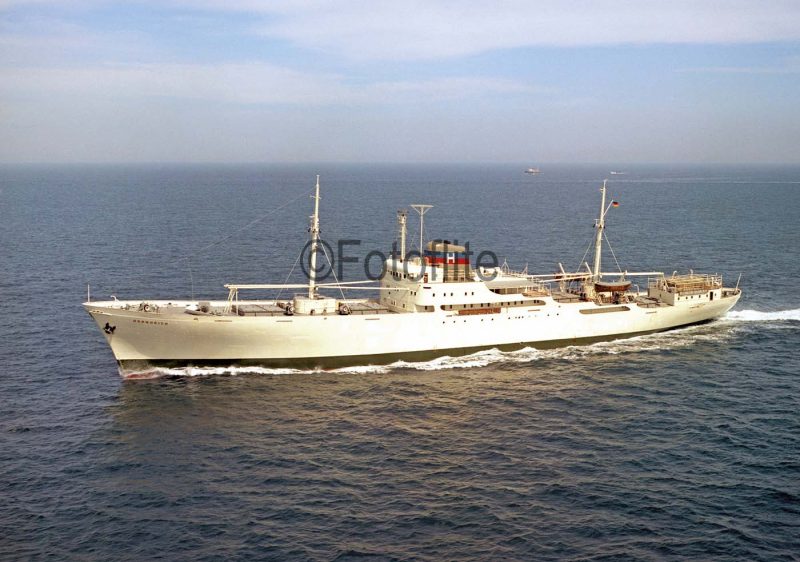
French Line Control of Horn Line
Chargeurs Reunis had previously carried fruit homewards from West Africa for French Line, but the latter started carrying fruit in 1933 when it purchased seven second hand small ships. These were Caraibe, Marigot, Grande Terre, Petite Terre, Basse Terre, Caravelle and Martinique, with three new motorships delivered in 1935 from the Odense and Gotaverken yards as Fort de France, Fort Royal and Fort Richepanse of 4,279 grt and 2,950 dwt for the joint ownership of the Compagnie de Transports Isothermiques with a Swedish shipping company. One J. Lauritzen reefer of 1,794 grt was also purchased and renamed Guyane for the Caribbean fruit trade in 1934.
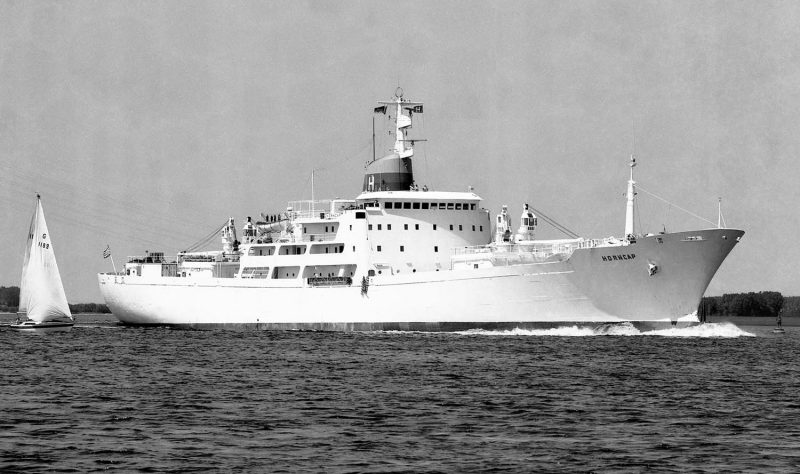
All of this first French Line reefer fleet was lost during World War II. A start on building a new reefer fleet was made in 1949 when a trio was ordered from the Alexander Stephen yard on the Clyde, and delivered as Fort Richepanse (2), Fort Royal (2) and Fort Dauphin. Two purchased vessels came from Sigurd Herlofsen of Norway and were renamed Fort Duquesne and Fort Saint Louis in the same year. Seven new reefers followed during the 1950s in Fort Carillon, Fort Desaix, Fort Royal (2), Fort Caroline, Fort Saint Pierre, Fort Frontenac and Fort Niagara, with the engines aft Baltic feeder vessel Baltique acquired in 1956. French Line had the second largest reefer ship fleet in Europe in 1967, Lauritzen of Denmark having the largest, with six recently built as Fort de France (2), Fort Fleur d’Epee, Fort Crevecouer, Fort D’Orleans, Fort Josephine and Fort Trinite. All of their big fleet were noted for the use of advanced vertical ventilation systems. Chartered ships were used during the seasonal fruit trades, with Hornbelt of 1958 chartered for three years from 1973. Fort La Reine and Fort Pontchartrain were two larger ‘third generation’ reefers of 8,500 dwt and a service speed of 21 knots from the Penhoet yard at St. Nazaire in 1969.
CGM French Line had acquired all of the shares of Horn Line in 1978, and ordered four reefer container ships of 1,512 TEU capacity, with half of these reefer containers, from the Societe Navale Dunkerque yard at Dunkirk for delivery in 1979/80 for the carriage of Caribbean bananas. Fort Royal, Fort Fleur d’Epee, Fort Saint Charles and Fort Desaix took over most of the CGM fruit carrying requirements, with only smaller traditional reefers from Horn Line and other chartered ships needed during the short seasonal fruit trades. Fort Sainte Marie of 1969 and her sister Aquilon from the former Messageries Maritimes fleet with four holds and 341,670 cubic feet of refrigerated space became Hornbay in 1981 and Horncap. Pointe-Sans Souci, Pointe-Madame and Pointe-La Rose of 1973 of CGM French Line became in 1986 Hornstar, Horngulf and Hornwind respectively. They had three holds served by five hatches, side and stern doors, a well deck crane of 35 tonne capacity and another aft, and 355,890 cubic feet of refrigerated capacity. They were broken up after twenty years of service in 1993 at Alang and in Turkey.
Hornsund of 13,750 dwt was purchased in 1978 and had been completed a year earlier as Torasund, she had three holds forward of her navigating bridge and two aft. Hornfels (2) was completed in 1985 as an engines aft reefer with two portside cranes, and apart from a spell as CGM Tchekov between February, 1990 and April 1993, was in the Horn Line fleet until sold in April 2000. Three Blue Star Line reefers and two Universal reefers were chartered for short periods as Hornsound, Hornsea, Horncliff, Hornwave and Hornwind.
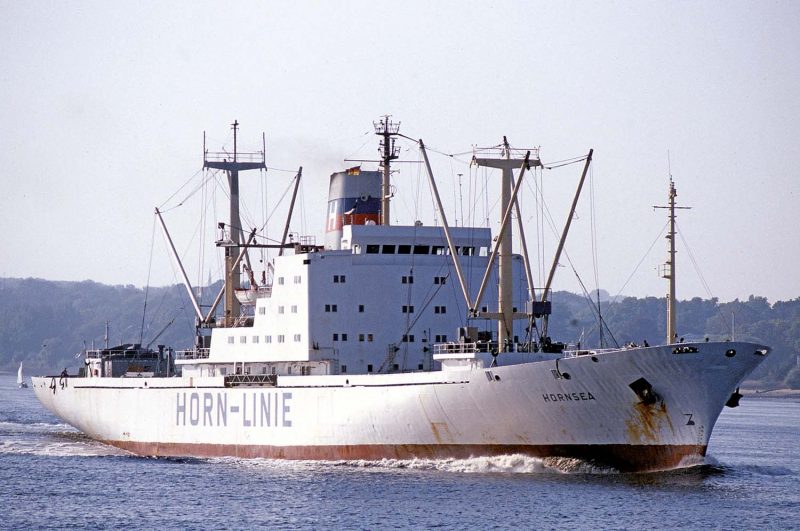
The Horn Line fleet was boosted during 1990/92 by the delivery of a trio of reefers from the Brodogradiliste Uljanik yard at Pula as Hornbay, Horncap and Horncliff. This trio of engines aft reefers have four holds and seven hatches served by four pedestal cranes each of 25 tonnes lift capacity, and hull dimensions of length 153.5 metres and moulded beam of 23.0 metres. They measure 12,887 grt and 9,096 dwt and have a side/quarter ramp for fifty tonne loads, and carry 198 TEU of containers with reefer plugs for half of that number. The holds have a cubic capacity of 525,630 cubic feet, and a high service speed of 23 knots ensures timely arrival of their cargoes.
Horncliff lost ninety containers overboard and suffered damage to several more deck containers as well as an 18 inch crack in her hull and the loss of her port anchor in a Force 10 storm on 1st February 2008 when 225 miles west of the Isles of Scilly, forcing her to anchor in Carrick Roads at Falmouth for repairs. There were 31 passengers and crew on board, but seven people including her injured Master needed to be airlifted to safety when they neared Land’s End. Horncliff had been on a voyage from Puerto Limon to Dover with fruit and was repaired, but the trio were offered for sale or long term charter in October 2016 after 26 years of service. The trio were still trading with fruit from Moin in Costa Rica to the U.S. Eastern Seaboard in April 2017 on Del Monte voyages.
Del Monte Control Of Horn Line
At the beginning of the 1990s, the American fruit and food company Del Monte Fresh Foods took over all of the shares of Horn Line, including the new trio of Horn Line reefers, and seven years later integrated the fleet into their Network Shipping Ltd. subsidiary in Coral Gables in Miami. Del Monte is a global producer, marketer and distributor of fresh fruit, food and vegetables in North America, Europe, the Middle East and Africa. It was founded in 1886 in San Francisco by an Oakland food distributor of canned peaches. The Del Monte brand was one of several brands introduced in 1898 by the California Fruit Canners Association (CFCA), which became the California Packing Corporation (CPC) in 1916. The CPC name became obsolete in June 1967 and the name of its leading brand, Del Monte, was chosen as the Del Monte Corporation for future trading.
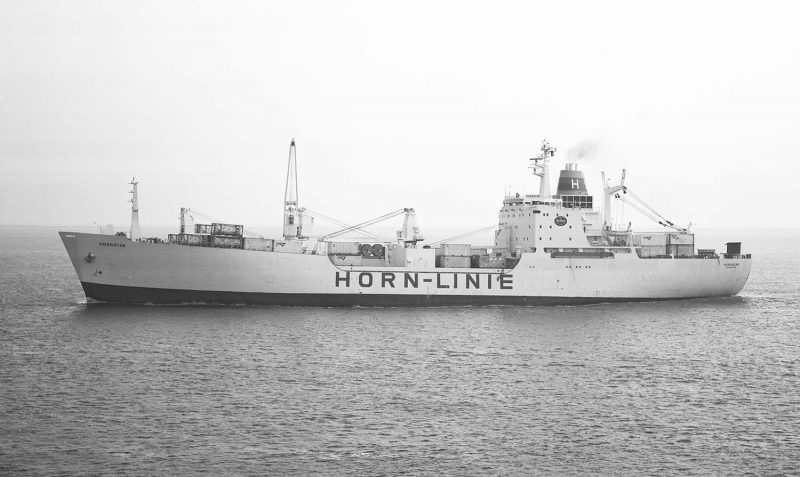
Del Monte purchased its first reefer from French Line in 1972 for its West Indies Shipping Ltd. subsidiary, the vessel was the former Fort Frotenac built in 1958 of 3,901 grt. The renamed Lord Frontenac served Del Monte until she collided in Galveston Bay on 22nd January 1980 with the Greek ship Cephalonia, sustaining such severe damage that she was broken up at Brownsville (Texas) three months later. Ocean Carrier Services of the Del Monte Corporation ordered nine reefers from Astilleros Espanoles in Spain for delivery in 1990/91 to give them a total reefer fleet of a dozen ships in service. The new reefers were Del Monte Consumer, Del Monte Harvester, Del Monte Trader, Del Monte Pride, Del Monte Spirit, Del Monte Quality, Del Monte Packer, Del Monte Planter and Del Monte Transporter. The first three in this list were sold to Irgens Larsen A/S of Norway in 1990 and chartered back for ten years and renamed Tundra King, Tundra Prince and Tundra Queen, the second trio in the list were sold to Actinor Shipping A/S of Norway without change of name, while the last trio in the list remained owned by Network Shipping Ltd. in Coral Gables.
In 1999, there was a change in the ship naming policy of Del Monte similar to the oil majors, who wished to remove all mention of their brand names in case of oil spillage or catastrophic damage. The words ‘Del Monte’ were removed from their newest nine reefers, and a number of former Salen of Sweden reefers were purchased and given names ending in ‘Carrier’ e.g. Alcazar Carrier (ex Winter Moon), Alicante Carrier (ex Winter Star), Cadiz Carrier (ex Winter Water), Malaga Carrier (ex Winter Wave), Segovia Carrier (ex Winter Sea) and Valencia Carrier (ex Spring Bride). This Spanish themed naming system was continued with Alcantara Carrier, Andalucia Carrier, Cordoba Carrier, Giralda Carrier, Granada Carrier, Sevilla Carrier, Toledo Carrier, Aracena Carrier, Lucenda Carrier, Ronda Carrier, and Murcia Carrier. The Del Monte fleet in 2017 comprised of fifteen owned and eight chartered reefers.
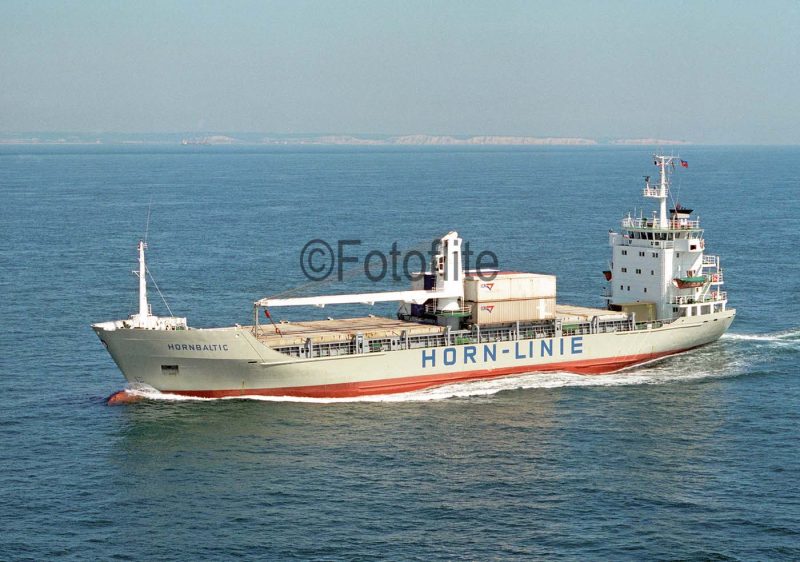
Postscript
The Horn Line is best remembered today as the owner of a large fleet of handsome white hulled reefer ships that began to be built up in 1951, but it also had a much larger earlier fleet of colliers, tramps and cargo-liners. Two different branches of the company were established on 1st July 1975 as Reederei Horn Linie OHG and the ship brokers Schiffahrtskontor Horn Linie OHG. The shipping company was part of French Line and Hapag at that time, and later passed to the Del Monte Fresh Foods empire.
The Horn Linie OHG management office was located in the fashionable City-Sud quarter of Hamburg, but the company was liquidated at the end of 2009.
The last Horn Line Caribbean service with passengers from Hamburg and Antwerp to Puerto Limon started with Hornbay sailing on 17th October 2009 from Antwerp, calling at Le Havre two days later and then Ponta Delgada, Pointe a Pitre, Fort de France, Cartagena, Turbo, Puerto Limon and returning to Dover. The last Horn Line Cameroon service from Hamburg to Douala started at the end of November 2006. The trio of Hornbay, Horncap and Horncliff then continued on Del Monte voyages in 2010 carrying only fruit, no passengers or ro-ro cargo managed by Norbulk Ltd. Thus, one of the greatest German shipping companies that owned two hundred good looking ships over 140 years and flew colourful red and blue houseflags passed into oblivion.

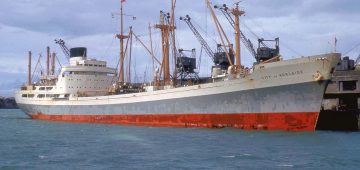
Comments
Sorry, comments are closed for this item